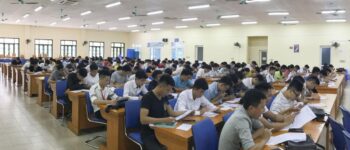According to Conclusion No. 91-KL/TW of the Politburo on continuing to implement Resolution No. 29-NQ/TW dated November 4, 2013 of the 11th Party Central Committee “On fundamental and comprehensive innovation of education and training, meeting the requirements of industrialization and modernization in the conditions of a socialist-oriented market economy and international integration”, besides the achieved results, there are still some limitations and shortcomings.
- Quận Ba Đình trao quyết định cho 17 thầy cô làm HT, hiệu phó trường công lập
- Hà Nội giao bổ sung thêm 3.200 chỉ tiêu tuyển sinh vào lớp 10 năm học 2024-2025
- PH ý kiến việc góp tiền mua tivi, Hiệu trưởng THCS Thanh Dương nhắn tin đe dọa
- Nam sinh Hà Tĩnh vượt khó để thành thủ khoa đầu vào, UTT trao học bổng 100 triệu
- Trường Đại học Thương mại tổ chức Hội thảo khoa học về đào tạo trình độ thạc sĩ
Therefore, the Politburo requested Party committees at all levels, authorities, the Vietnam Fatherland Front and socio-political organizations to focus on implementing eight key tasks to continue promoting the achieved results and overcome and resolve limitations.
Bạn đang xem: Thầy cô sẽ thêm yên tâm bám trường, bám lớp nếu kiên cố hóa trường lớp
Specifically, the seventh task of the conclusion clearly states: Implement the program of investment in solidifying schools, eliminating temporary classrooms, building national standard schools and ensuring adequate facilities and minimum teaching equipment, especially in rural areas, ethnic minorities, mountainous areas, border areas, and islands, striving to have 100% of solidified classrooms by 2030.
Reinforcing schools and classrooms creates motivation for teachers to stay in school and classrooms with peace of mind.
Speaking to reporters of Vietnam Education Electronic Magazine, Mr. Dinh Trung Tuan – Director of the Department of Education and Training of Lai Chau province said that the implementation of solidifying schools and classrooms plays a very important role, in order to meet the material facilities serving the 2018 general education program and the planning of the school network for the period 2026-2030.

Mr. Dinh Trung Tuan – Director of the Department of Education and Training of Lai Chau province. Photo: Lai Chau province electronic information portal.
Therefore, the education sector of Lai Chau province continues to advise the Party Committee and authorities at all levels to build school and classroom facilities to meet the teaching and learning needs of teachers and students and improve the quality of human resources in the period of national economic development; focus on planning the network of schools and classes, consolidating and developing the system of semi-boarding high schools and boarding high schools.
Through many efforts and struggles to solidify schools and classrooms, Lai Chau province currently has 7,305 classrooms, of which 5,715 are solid classrooms, reaching 78.2%.
Mr. Dinh Trung Tuan shared: “With the attention of all levels and sectors, along with the contributions of collectives and individuals, the school network system has been consolidated, and the facilities have been enhanced. Many new schools, ensuring spaciousness, ventilation, and pedagogical landscapes have been invested in and built solidly, especially schools in remote areas.
Thanks to that, teachers can feel secure in their schools and classes, parents can feel secure when their children live and study in the best conditions, students like to go to school more, contributing to creating positive changes to help improve the quality of local education.

Ta Tong Primary and Secondary Boarding School for Ethnic Minorities (Muong Te District, Lai Chau Province). Photo: Lai Chau Department of Education and Training provided.
The ability to attract investment capital outside the state budget is still limited.
The Director of the Department of Education and Training of Lai Chau province also said: “Although the locality has been making efforts in implementing the solidification work, it still faces many difficulties due to limited resources, and the mobilization of contributions from individuals and organizations inside and outside the province for education is still not much.
In addition, the socio-economic conditions of the people in Lai Chau province are still difficult, the population density is sparse and not concentrated. The traffic connection system is not synchronous, leading to the ability to attract investment capital outside the state budget is still limited.
Speaking to reporters, Mr. Tong Thanh Son – Head of the Department of Education and Training of Muong Te district (Lai Chau province) also said that the work of solidifying schools, classrooms and public housing in the area is still facing many difficulties despite the efforts of the education sector.
“Muong Te is a remote district with difficult transportation. If we plan only one school in the central area, it will not be suitable. We must have separate schools spread out in different areas.
Thus, the investment in construction will be very costly because each school must ensure the requirements for classrooms, playgrounds, kitchens, etc. while the district is poor, the budget allocated for education is still difficult, leading to the situation that many schools have not been solidified, and the land area of some schools is not yet guaranteed,” Mr. Son shared.
Up to now, the total number of classrooms in Muong Te district (including subject classrooms) is 882 classrooms: 665 solid classrooms, 206 semi-solid classrooms, 11 temporary classrooms (9 temporary classrooms less than the previous school year); an estimated 194 public service rooms: 93 solid rooms, 91 semi-solid rooms, 10 temporary rooms. The rate of solidification of schools and classrooms is 75.4%, the estimated rate of public service rooms is 47.9%.

Mr. Nguyen Cong Thuong – Principal of Nam Nga Primary and Secondary Boarding School for Ethnic Minorities (Muong Te District, Lai Chau Province) also said that with the attention and investment of departments, branches and units, up to now, the solidification conditions of the school have been significantly improved.
Accordingly, the classrooms are sufficient for students to study, the boarding house is also in the process of completion, expected to be handed over in the next school year. Previously, the school had 12 boarding rooms, but due to the large number of students, the school invested in building 15 more boarding rooms and 6 functional rooms, currently under construction and will be handed over in the shortest time.
Regarding the teachers' housing, Mr. Nguyen Cong Thuong shared: “Because the school has just moved to Nam Nga commune, there is no housing yet, teachers are still living in wooden houses. Therefore, living conditions are often affected when encountering rainy and windy weather, teachers will have a harder time, and the safety level is not as high as in solidly built houses.
If investment is made to build public housing, teachers will certainly have more motivation and feel more secure in their work, staying closer to the school and the village.”

The living conditions of teachers at Nam Nga Primary and Secondary Boarding School for Ethnic Minorities (Muong Te District, Lai Chau Province) are still difficult and arduous. Photo: NTCC.
According to Mr. Vu Van Vien – Principal of Pa Ve Su Primary Boarding School for Ethnic Minorities (Muong Te District, Lai Chau Province), recently, with the attention and support of local authorities, sectors and benefactors, the school has built 2 new schools, and has also gradually repaired and improved school and classroom conditions.
However, at present, at the two main schools that provide boarding students, there is still a lack of boarding rooms for students and public rooms for teachers. Therefore, the Principal also expressed his hope to receive more attention from social resources, in addition to the limited budget.

Xem thêm : 32 thí sinh đạt giải cuộc thi tiếng Anh TOEFL Primary Challenge và TOEFL Junior Challenge
At some schools, teachers at Pa Ve Su Primary Boarding School for Ethnic Minorities (Muong Te District, Lai Chau Province) are still living in temporary public offices, with living conditions not guaranteed. Photo: NTCC.
Regarding this issue, the Director of the Department of Education and Training of Lai Chau province emphasized: “Determining that consolidating schools and classrooms is necessary to improve the quality of education and training; it is an important condition to ensure the safety of teachers and students.
In the coming time, the education and training sector of Lai Chau province will conduct a survey and advise the Provincial People's Committee to arrange funds for investment in the construction and repair of schools and classrooms; integrate capital sources from national target programs to prioritize the construction and repair of degraded classrooms without investment projects, schools in disadvantaged areas and schools on the roadmap to build national standard schools. Promote the socialization of education, gradually eliminate temporary classrooms and degraded classrooms, and ensure facilities for teaching.
Priority should be given to creating investment resources for education in disadvantaged areas.
In the context of limited budget, not meeting all the needs of localities, one of the important solutions is to strengthen and mobilize socialized education.
The Director of the Department of Education and Training of Lai Chau province said: “Implementing Resolution No. 35/NQ-CP dated June 4, 2019 of the Government on strengthening the mobilization of social resources for investment in education and training development in the 2019-2025 period; Plan 1237/KH-BGDDT dated November 28, 2019 of the Ministry of Education and Training on mobilizing resources for investment in education and training development in the 2019-2025 period. The Provincial People's Committee issued Plan No. 1493/KH-UBND of Lai Chau province dated July 23, 2020 on the implementation of Resolution No. 35/NQ-CP dated June 4, 2019 of the Government. The Department of Education and Training directed educational institutions to strengthen and promote the calling and attraction of socialized resources to invest in facilities, mobilize parents and students to participate in repairing and upgrading schools and classrooms.
Therefore, by the end of the 2023-2024 school year, the education sector has mobilized 63,925 million VND.
Specifically, the locality has repaired and upgraded 74 classrooms, 04 boarding rooms, 13 kitchens, 02 dining rooms, 24 toilets, 25 clean water facilities and many other artifacts,….”.

Boarding room for students of Tam Duong District Ethnic Boarding High School, Lai Chau Province. Photo: Provided by Lai Chau Department of Education and Training.
Along with local efforts and achieved results, the Department of Education and Training of Lai Chau province recommends that all levels and sectors continue to prioritize investment resources for educational development in border areas, remote areas, and ethnic minority areas.
In addition to the State's investment in building infrastructure, the education sector of Lai Chau province hopes to receive attention and support from businesses, social organizations, collectives and individuals at home and abroad to support investment and construction of classrooms, dormitories for boarding students and solid public housing for teachers to ensure conditions for carrying out educational tasks.
At the same time, purchasing equipment to serve the innovation of teaching and learning methods in the context of implementing the 2018 general education program; helping students in difficult circumstances, to contribute to improving the quality of education and training in the locality.
Thuy Quynh
https://giaoduc.net.vn/thay-co-se-them-yen-tam-bam-truong-bam-lop-neu-kien-co-hoa-truong-lop-post245036.gd
Nguồn: https://truonglehongphong.edu.vn
Danh mục: Giáo Dục









